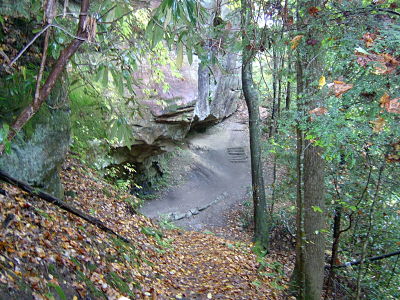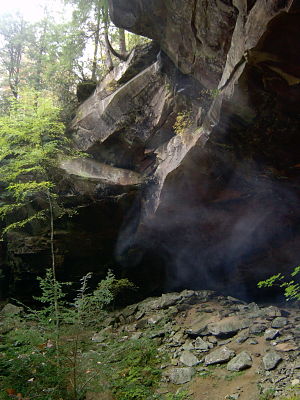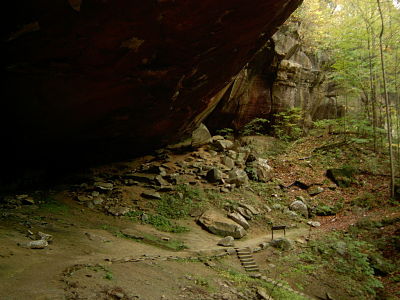

Trail leading to Yahoo Falls
Cave at Yahoo Falls
The Yahoo Falls Massacre
Yahoo is a local variation of the Cherokee word Yahula, which is a
traditional Cherokee story about a mixed-blood trader who lived in
a great stone house and was taken away by the Nunehi, the little people.
Yahula would sing his favorite songs as the bells hanging around the
necks of his ponies tinkled, echoing through the mountains along
the Great Tellico Trail, today known as US route 27.
The Great Tellico Trail extended from the Sequatchie Valley,
near present-day Chattanooga, Tennessee, to the Cumberland River Valley
of Kentucky, and beyond.
The Alum Ford Trail, today known as State Route 700, connected
the Great Tellico Trail with east-central Tennessee by way of an enormous
sandstone rock shelter located behind Yahoo Falls, one of the tallest
waterfalls in the state.
According to traditional Cherokee story tellers, one day, all the warriors left
on a hunt, but when it was over and they returned, Yahula was nowhere
to be found—the Nunehi had taken him to the Spirit World.
While he was there, Yahula made the mistake of eating the food of the
Nunehi, which meant that he could never return to his people except as a
Spirit. Although he was never seen again, the Cherokee believe that the
songs of Yahula and the tinkling bells of his horses can still be heard at
night near the running water of Yahoo Falls located in the
Big South Fork National River and Recreation Area,
McCreary County, Kentucky.
On the Trail of Tears, the story of Yahula was used to urge the people
forward to Oklahoma, suggesting that Yahula has gone there and we will
hear him, but they never did. The story of Yahula is hauntingly similar to
the story of Jacob Troxell and the massacre of Yahoo Falls.
In the winter of 1777-1778, Jacob Troxell, also known as Big Jake because
of his height, was a private in the Continental Army at
Valley Forge under the command General George Washington.
Jacob Troxell, born in 1758, was the son of a Jewish immigrant from
Switzerland and his mother was Delaware. In February 1778, word
reached Washington that British forces had abandoned the old French Post
Vincennes in present day Indiana, and it was in the hands of
American militia. Cherokee, Miami, Piankeshaw, and Shawnee, along with
Jesuits, Voyagers, and traders were using it. Washington’s staff assigned
Jacob Troxell to pose as a trader and go to Post Vincennes to persuade as
many American Indians as possible to support the Continental Army in
their war against the British.
At Port Vincennes, Jacob Troxell befriended a young Cherokee warrior
about his same age from the Cumberland River valley,
Tukaho Doublehead, son of Taltsuska (Doublehead) and Creat Priber.
Doublehead was born in McCreary County, Kentucky, son of
Wilenawa (Great Eagle), grandson of Moytoy, and great-grandson of
Amatoya Moytoy—a fourth generation Principal Chief of the
Cherokee Nation. Tukaho invited Jacob Troxell to his village, Tsalachi,
which was located near present-day Burnside, Kentucky. In the summer of
1779, Doublehead welcomed his son’s new friend and invited him to stay
and trade with his people. Not long afterwards, Jacob Troxell became
smitten over one of Doublehead’s four daughters.
During the winter of 1779-1780, Tory infantry from Watauga, under the
command of Major Patrick Ferguson, British Commander of the
71st regiment, were robbing and killing Cherokee hunters as they
traversed the Great Tellico Trail. Jacob Troxell accompanied Doublehead
and his daughter in their attack on a Tory camp on the Little South Fork,
in what is today Wayne County, Kentucky. He used the incident to explain
why Doublehead and his warriors should support Washington and the
colonial army. Jacob Troxell successfully completed his mission.
At the decisive Battle of Kings Mountain, October 7, 1780, there were
Cherokee warriors fighting against the British. Among them was
King David Benge, nephew of Red Paint Clan Mother, Wurteh,
granddaughter of Doublehead, and first cousin of Sequoyah.
Following the end of the American Revolution, Jacob Troxell married the
sister of Tukaho and soon had a son known as Little Jake. By this time,
Cherokee living in the Cumberland River valley were almost
unrecognizable to the whites now settled in the area.
Jacob Troxell and his family, like other Cherokee, lived in a cabin, herded
cattle, horses, and pigs, and used metal farming tools to tend crops of
potatoes, native corn and beans, orchards of peach trees, and they kept
bees for honey and wax for trade. By this time, Doublehead had built an
estate near Muscle Shoals, Tennessee. His estate included twenty enslaved
African Americans and at least one mixed blood, thirty head of cows,
100 head of fine stock cattle, two stud horses, eight mares and geldings,
and nine head of common horses, fifty head of sows, pigs and small stock
hogs, and 100 head of large hogs. His home was furnished with four large
beds with contemporary bedding and bedsteads, six dining room and
twelve sitting chairs, dining room and kitchen tables, dishes and tableware,
large and small iron cooking pots, a brass kettle and teapot, three large
ovens, and three pair of iron fire dogs. Doublehead’s immense fortune
was thought to have come from money that he skimmed from treaty
entitlements.
News of Doublehead’s murder in 1807 spread across the Great Tellico Trail
and into the Cumberland River valley. Without the protection of his
powerful father, Tukaho Doublehead was powerless and vulnerable.
His people were greatly reduced in number and dispirited from fighting off
the advance of white settlers and smallpox. To make matters worse,
Tukaho Doublehead had married a white woman, Margaret Mounce, from
Cherry Fork, present-day Helenwood, Tennessee. The prejudice and hatred
of Doublehead’s people grew among European settlers. They hunted down
and murdered Jacob Troxell’s brother-in-law,
Tukaho Doublhead atop a ridge that still bears his name,
Doublehead Gap, in present-day Wayne County, Kentucky.
On January 15, 1810, the “War Hawks” of Congress expressed concern
about the Indian presence in Kentucky and extinguished all Cherokee land
claims in the state. Although the Cherokee in the Cumberland River valley
had made every possible concession to maintain peace with
the United States, many of the European settlers were former Franklinites,
followers of John Sevier. The European settlers’ hatred of the Cherokee
grew, in part, out of their indifference between those who fought Shawnee
in the Northwest Territory against Kentucky troops at Fallen Timbers,
Tippecanoe, and the River Raisin, and those who fought alongside
American forces in the Southeast against the Creek at the
Battle of Horseshoe Bend. Expecting the worse, Tukaho Doublehead’s
sister, Jacob Troxell’s wife, realized that the only way her people could
survive would be if they moved south on the Great Tellico Trail.
Between 1803 and 1804, her father had helped
Reverend Gideon Blackburn, a Presbyterian pastor from Jacob Troxell’s
hometown of Philadelphia, open a school on Cherokee land near
present-day Chattanooga, Tennessee. In the late summer of 1810,
Blackburn agreed to offer protection and education to all Cherokee women
and children from the Cumberland River valley.
Doublehead’s daughter sent Little Jake on horseback to spread the word
that anyone seeking protection at the Blackburn school in Chattanooga
should meet in the rockshelter behind Yahoo Falls when the moon was full
and round.
All that remained of Doublehead’s people in the Cumberland River valley,
mostly women and children, gathered at Yahoo Falls. They waited for
Doublehead’s daughter and her son, Little Jake, to arrive and lead them to
safety. Fearing that she was not going to show up, some of the mothers
gathered their children, shouldered their packs, and began to walk out of
the shelter. A volley of gunfire erupted from the darkness in front of the
falls. A local militiaman, Hiram Gregory, had learned of the gathering
behind Yahoo Falls, enlisted a group of young vigilantes, and set out to
exterminate the Cherokee from the Cumberland River valley once and for
all. Gregory’s mercenaries focused their initial attack on the few warriors
that were present, and then they been began to slaughter the women and
their children. Campfires illuminated the shelter leaving the Cherokee
completely open and exposed—there was nowhere for them to run or hide.
After it was all over, more than 100 Cherokee lay dead or dying behind
Yahoo Falls. Doublehead’s daughter died from injuries received during the
massacre. She was buried at the base of a large flat stone in what is today
Stern’s Kentucky, the birthplace of her father. Jacob Troxell was said to
have lost his mind in grief. A mass grave was excavated in a high terrace
behind the falls, the only place where the soil was deep enough to dig a
trench. The bodies of the slain Cherokee men, women, and children were
laid to rest until the grave was exposed during logging operations during
the early twentieth century.
The exact date of this horrific event is unknown. Some say that the
massacre occurred on the 130th anniversary of the Pueblo Revolt,
August 10, and others have placed it in the fall, early October. Regardless
of the exact day and month, all of the published documents and family
histories agree that the massacre of Yahoo Falls took place in the latter
half of the year 1810. There is a similar misunderstanding on the date and
place of death of Big Jake Troxell.
Although the military tombstone along SR 700 reads Jacob Troxell,
Pennsylvania, Pvt, 6 Co., Philadelphia, Co. Militia, Revolutionary War,
January 18, 1758, October 10, 1810, family records indicate that he was
taken to Alabama where he lived until 1817. If he suffered catatonic
depression following the death of his Cherokee wife as reported, then he
would have been considered a living dead man, a person whose body was
alive, but his spirit had left him, a situation not unlike the trader in the
story of Yahula.
There is also great deal of confusion about the death of Doublehead.
What most people missunderstand is that there were many Cherokee
named Doublehead because all of his thirteen children with four wives
were named Doublehead—Tukaho Doublehead, Tuskiahoote Doublehead,
Saleechie Doublehead, Nigodigeyu Doublehead, and
Gulustiyu Doublehead with Creat Priber—Bird Tail Doublehead
and Peggy Doublehead with Nannie Drumgoole—Tassel Doublehead,
Alcy Doublehead, and Susannah Doublehead with
Kateeyeah Wilson—Two Heads Doublehead, Doublehead Doublehead,
and William Doublehead with an Cherokee woman whose name is
unknown. Because Tukaho Doublehead’s murder occurred in the same
year as his father, 1807, the two events have been confused.
Chief Doublehead was murdered in Tennessee and
Tukaho Doublehead was killed in Kentucky.
Perhaps the biggest problem with all versions of the massacre, both
written and oral histories, is that Jacob Troxell’s wife, Tukaho’s sister,
Doublehead’s daughter, was named “Princess Corn-blossom.” The first
problem with the name Princess Corn-blossom is that there was no such
thing as a “Cherokee Princess.” The term came from the time when
Moytoy (1730-1760) was the Principal Chief of the Cherokee.
Sir Alexander Cuming proclaimed him as King of his people.
If Moytoy was a King, then his daughters must have been princesses.
Doublehead was the son of Great Eagle, who was the son of Moytoy, and
tribal leadership was passed down from father to son.
Princess is the way eighteenth century British communicated the kin term
daughter of a Chief. Secondly, the name Corn-blossom is not a Cherokee
word. While Corn-tassel (Utsidsata and Onidosita) and
Corn-silk (Seluunenudi) are Cherokee words that approximate
Corn-blossom, they are masculine names. One of Doublehead’s children by
Kateeyeah Wislon was named Tassel. Unfortunately, the gender of the
offspring is unknown and was not born until about 1798.
Cherokee census and enrollment records indicate that Doublehead had
four daughters living with him at the time Tukaho brought Jacob Troxell to
Tsalachi and they were all very close in age—
Tuskiahoote, Saleechie, Nigodigeyu, and Gulustiyu respectively.
Tuskiahoote and Saleechie were both reported as the wives of
Colonel George Colbert, and Nigodigeyu and Gulustiyu were reported as
the wives of Samuel Riley. We can rule out Saleechie Doublehead because
it is well documented that she survived the Trail of Tears and died in
Indian Territory, Oklahoma in 1846. Tuskiahoote Doublehead is thought to
have lived until 1817, but we cannot rule her out because this date is by
no means a certainty. It is also interesting that Tuskiahoote Doublehead’s
death date not only matches that ofJacob Troxell, she reportedly died in
Alabama.
Samuel Riley is an especially interesting character because he seized most
of Chief Doublehead’s personal property after his murder in 1807.
Furthermore, he was known as the "White Patron" of
Gideon Blackburn's School, the same school Doublehead’s daughter was
taking the Cherokee of the Cumberland River valley to at the time of the
massacre. Although Riley is reported to have fathered five children by
Nigodigeyu and eleven by Gulustiyu, it is quite possible that he falsely
claimed two wives in order to ensure his entitlements to Doublehead’s
fortune. On April 28, 1819, Riley filed a suit for Doublehead’s entitlements,
about fifteen days before he succumbed to an illness.
He is assumed to have been Doublehead’s son in law solely on the basis of
his last will and testament, which was accepted by the
Supreme Court of the Cherokee Nation on October 25, 1825,
as recorded by John Martin.
On January 31, 1811, just months after the Yahoo Falls massacre, the
former Cherokee land was granted for sale at the minimal price of ten
cents an acre in order to encourage the development of iron and
salt works. As salt was an expensive commodity at $25.00 a barrel, the
families who had orchestrated the Yahoo Falls massacre purchased the
land containing salt springs and became rich.
During the first forty years of the 20th century, blight devastated the
American chestnuts. Although the blight provided an economic boom to
the local timber industry, logging operations deforested the shallow
unstable soils around Yahoo Falls. Unprecedented erosion extended into
the great sandstone rock shelter behind the falls and exposed a mass
grave filled with human skeletal remains. Grave robbers, artifact collectors,
curiosity seekers, and gravity began to disperse bones down slope until it
was impossible to walk into the shelter without stepping on them. All that
survives is an empty trench behind the falls, which approximates the size
of the mass grave at Wounded Knee Memorial on the
Pine Ridge Reservation in South Dakota. Today, Yahoo Falls is located in
the Big South Fork National River and Recreation Area,
National Park Service, McCreary County, Kentucky.
The Cry of The Hawk: The Yahoo Falls Massacre
"Big Jake" Troxell, was a half-breed Delaware Warrior from Pennsylvania who had been sent by the personal staff of President Washington to sway the Cherokee away from the Spanish and to ally with the New Americans. But after seeing the inhumane treatment the new settlers inflicted on the Indians in southeast Kentucky and northern Tennessee, Big Jake ended up joining the Cherokee instead.
Chief Doublehead's daughter was the beautiful Cornblossom. She and Jake fell in love and were married. When the Chief was assassinated, Cornblossom became the leader of her tribe. In the forty years since Boone and forty others had built the first fort on the Kentucky River, the depredations in the war between natives and settlers had only gotten worse. Cornblossom, a skilled warrior, believed that the future of her people lay in education and assimilation with the white settlers. In the summer of 1810, she began to lead a group to the Sequatchie Valley near Chattanooga, Tennessee. They would be safe there, enrolled as members of a Presbyterian school for Indians. Her tribe was to meet at the rock house beneath Yahoo Falls to begin their migration south.
Having learned of this meeting, the local Franklinites under Hiram Gregory, decided to exploit the opportunity. Hiram 'Big Tooth' Gregory and a band of hardened Indian fighters from some of the counties to the southwest crossed into Cherokee territory on horseback, gathering at what is now Flat Rock Kentucky, before heading into the Yahoo Falls area. Jake Troxell was being realistic when he figured that likely as not, there would be trouble. He was already guarding the landward approach to the falls with a few other long hunters and a small group of Chickamauga warriors.
Shortly after midnight on August 10th, Hiram Gregory's men approached. A young Indian in Jake's line bolted. this was a runner who tried to warn the people gathered under the rock shelter to scatter, but the boy was immediately shot down. Big Jake and the front guard were quickly overpowered and scalped. The Indian fighters rapidly advanced to the falls area. Lining themselves along the edge of the bluff surrounding the large opening below, they began firing from all sides on the children now trapped directly underneath them. Those who were in the valley away from the falls hid and escaped. 100 children and some old men, pregnant women, and mothers huddled underneath the falls. Big Tooth and his men worked their way down toward the floor of the rock house on the two side paths while gunners up top kept their prey trapped. The Natives had a few hatchets but no other weapons. A woman warrior named Standing Fern, daughter-in-law of Cornblossom, bravely rushed the paths with a few others in a desperate attempt to stop the murder. They were soon killed but managed to take out a few of their attackers.
Some of these Kentucky Indian fighters had fought alongside Governor John Sevier, an infamous Indian killer, who is credited with having coined 'nits make lice'; the same phrase used by Colonel Chivington, summarizing a certain mindset before the massacre at Sand Creek, Colorado in 1864. Although the tragic butchery at Yahoo falls was not unique or extraordinary in the history of western settlement, most Americans know nothing about it and very little about other similar events. Such genocidal actions continued for most of the nineteenth century. Gregory's men killed elders, raped women and younger female children of all ages, and cut bellies open. Altogether, they senselessly murdered and scalped over 100 Chickamaugan Cherokee women and children that had begged for their lives.
Later that morning, Cornblossom who was travelling behind with a separate party, approached the great rock house with her children. As they came closer to the falls area, it is said a hawk flew above them and lit in a nearby tree in a way that told the Princess something was wrong. The Cherokee were especially sensitive to the spirit power expressed in birds. The party anxiously pushed onward to get the children to the falls and safety. Arriving at the entrance area, she found Jake and the front guards brutally scalped. Leaving the children there with some women, Cornblossom, her son War Chief Peter Troxell, Red Bird, and their party of warriors rushed to the Falls where some of Gregory's gang still going at it. Cornblossom screams to her warriors to kill these animals. Peter Troxell died underneath the falls and his mother suffered an agonizing gunshot injury.
Two days later this wound ended Cornblossom's life. It is said that her last words were, "We Are Not Conquered
Yet ... Remember My Children .... Remember My People".
This massacre essentially destroyed the Chickamaugan Cherokee from southwest Kentucky to Knoxville. With no powerful leaders left in Kentucky and the Cumberland Plateau, many Cherokee decided to leave the area in fear of the whites, while others sought isolation by hiding in the hills. The settlers who comprised the Kentucky and Tennessee militias considered this affair the last of the resistance movement of the Kentucky and northern Tennessee Cherokees. This was the year Captain Black Fox finally decided to move his people to Arkansas where, hopefully, they could pursue a new life in peace. But one who would not ever leave the region was Little Jake, youngest son of Jake and Cornblossom. He had arrived with his mother late that morning and helped kill a few of Gregory's men. It was an experience he would never forget. Little Jake grew up and became a famous renegade, terrorizing settlers in the Big South Fork area for years.
Standing beneath Yahoo Falls



To see our photo albums
of Yahoo Falls, please use
the provided links